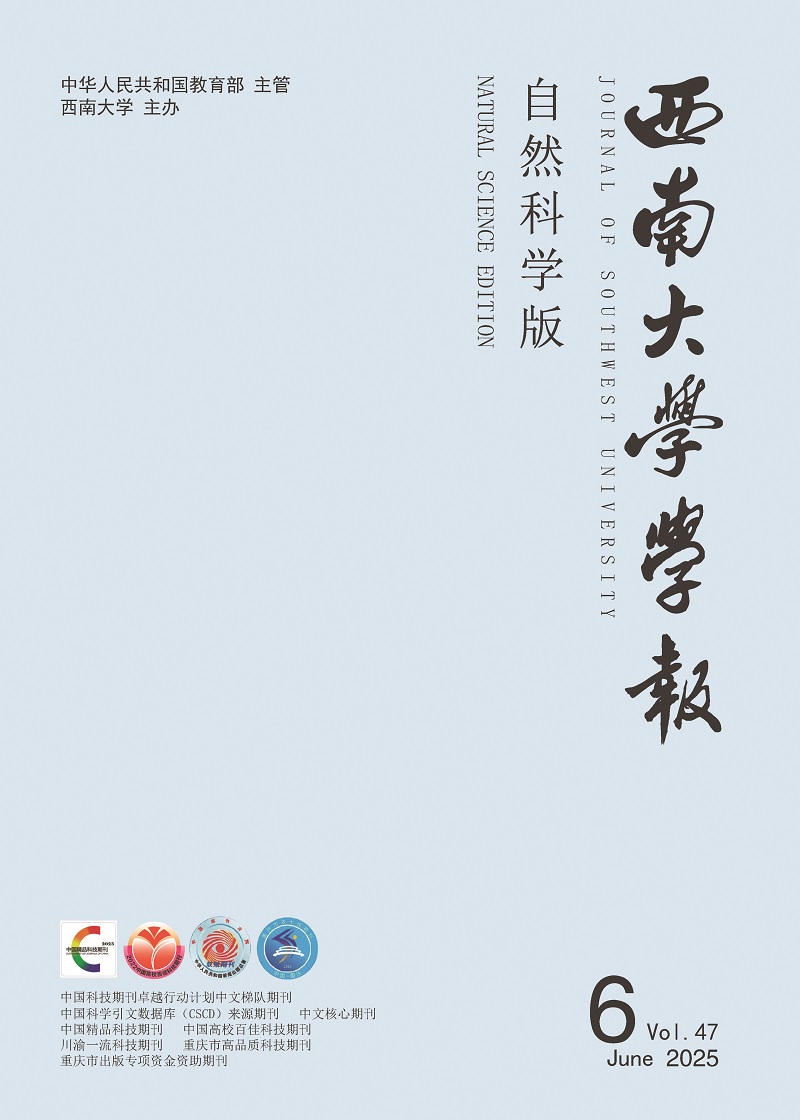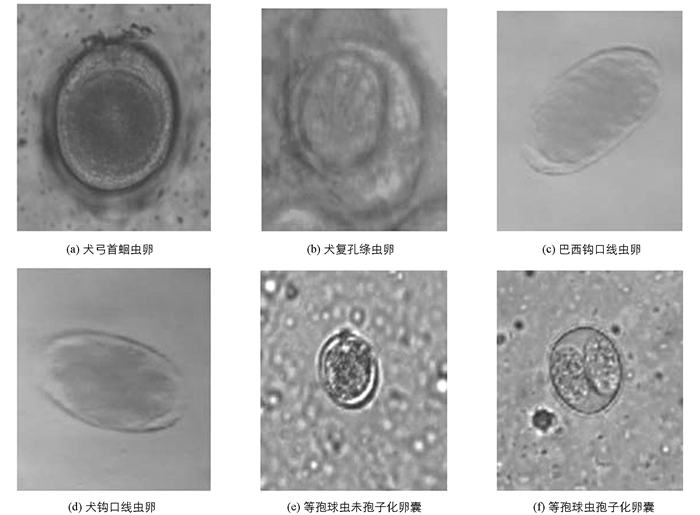-
犬寄生虫病是一类很普遍的疾病,各种寄生虫不仅危害犬的健康,而且有些寄生虫还对人体组织器官造成不同程度的病理损伤,引起严重的人畜共患病,直接危害人类健康[1-3].犬感染寄生虫种类较多,尤其是肠道寄生虫[4-6],常引起犬消瘦、贫血、腹泻及生长发育受阻,严重者导致犬死亡.
消化道内寄生虫是犬最常见的病原,多数无临床症状,通常幼犬易感[7-8].犬蛔虫、钩虫系土源性寄生虫,发育中不需要中间宿主参与,虫卵随犬粪便排出体外,需在外界适宜条件下发育到感染期被犬吞食而感染.犬复孔绦虫系生物源性寄生虫,发育需要中间宿主参与.其虫卵随粪便排至外界,被中间宿主蚤类吞食后,在蚤体内发育为似囊尾蚴,犬吞食蚤类而感染.此外,犬还是多种人畜共患病的传播者,如棘球绦虫的幼虫——棘球蚴能引起家畜死亡,不仅给畜牧业生产带来严重的经济损失,而且严重影响人类健康[9].
为了解重庆市荣昌区犬消化道寄生虫的感染情况,笔者于2015-2016年对荣昌区6个街镇犬的消化道内寄生虫感染情况进行了调查,以期为该区犬寄生虫病的综合防治提供依据.
HTML
-
随机选取不同品种和年龄的犬作为采样对象.对被检犬取刚排的新样粪便,分别装入干净的塑料袋中,标上编号、年龄标签,置于4 ℃冰箱备查.
-
取5~10 g待检样本,用10 mL清水搅拌均匀,之后再加入40 mL清水搅拌均匀,用60目和150目网筛双层过滤,将滤液以3 000 r/min离心10 min,弃上清液,加入50 mL饱和食盐水用干净的玻璃棒搅拌均匀,再以1 500 r/min离心10 min,然后用金属圆环轻触表层液制片,在显微镜下观察.
-
取5~10 g待检样本于烧杯中,加适量清水调匀,将其过滤于另一干净烧杯中,将滤液静置20 min后,弃上清液,再加入清水搅匀,再沉淀,如此反复进行2~3次,至上清液清亮为止.最后弃上清液,用滴管吸取少许沉渣于载玻片上,再加一滴清水涂匀,加盖玻片镜检.
-
取待检样本5~10 g,加水搅匀,先通过40目或60目的网筛过滤;滤下液再通过260目锦纶筛兜过滤,并在锦纶筛兜中继续加水冲洗,直到洗出液体清澈透明为止;而后挑取锦纶筛兜内的粪渣抹片、镜检.
-
对不同年龄和品种犬的感染率采用X2检验进行分析,p>0.05为差异性不具有统计学意义,p≤0.05为差异性具有统计学意义.
1.1. 样品采集
1.2. 样品处理
1.2.1. 饱和盐水漂浮法
1.2.2. 虫卵沉淀法
1.2.3. 锦纶筛兜淘洗法
1.2.4. 数据分析
-
采取了重庆市荣昌区昌元、广顺、峰高、安富、双河和直升6个镇街的209份样本,共检出5种消化道内寄生虫,分属4个科4个属(图 1,表 1).
-
本次试验共检查了209个样本,其中感染比较普遍的是犬弓首蛔虫,阳性率为77.03%;其次是犬钩口线虫,阳性率为37.32%;犬复孔绦虫的感染率为35.88%;等孢球虫的感染率为25.84%;感染率相对较低的巴西钩口线虫,感染率为21.53%(表 2).
-
对不同年龄段犬的寄生虫感染情况进行调查,结果发现1-6月龄的犬寄生虫感染率为98.68%,感染寄生虫种类也有5种;7-12月龄的犬寄生虫感染率为79.17%,感染寄生虫种类有5种;1岁以上的犬寄生虫感染率为68.85%,感染寄生虫的种类有4种(表 3).
-
对不同品种犬寄生虫感染情况进行调查,结果发现本地犬寄生虫感染率达到了96.55%;其次属杂交犬,为89.65%;宠物犬的感染率较低,为59.38%(表 4).
2.1. 犬消化道寄生虫种类
2.2. 犬消化道寄生虫感染情况
2.3. 不同年龄段感染情况
2.4. 不同品种犬感染情况
-
1) 本次共调查了209只犬的粪便样本,结果发现重庆市荣昌区6个街镇犬感染消化道内寄生虫有5种,分别为犬弓首蛔虫、犬复孔绦虫、犬钩口线虫、巴西钩口线虫、等孢球虫;其中以犬弓首蛔虫、犬钩虫的感染较为普遍,且感染率较高.弓首蛔虫感染率高达77.03%,犬钩虫的感染率也达到了58.85%. Mircean等[8]和Rodríguez-Vivas等[10]报道罗马尼亚和墨西哥的犬钩虫感染率分别达到51.9%和73.8%,与犬放养和当地温暖潮湿的气候密切相关.此外,高感染率还与犬缺乏日常预防性驱虫有关.本次试验结果发现重庆市荣昌区犬感染内寄生虫较为普遍,应重视该地区犬寄生虫病的防治.
2) 不同年龄段犬寄生虫的感染率经X2检验,发现1-6月龄和7-12月龄感染率差异具有统计学意义(0.001<p<0.05),1-6月龄和1岁以上的感染率差异具有统计学意义(0.001<p<0.05),7-12月龄和1岁以上的感染率差异不具有统计学意义(p>0.05).从表 3可见,随着年龄增长,犬寄生虫的感染率依次下降,本研究的结果与文献报道相一致[8, 11].通常幼犬对寄生虫的易感性最高,主要是由于经胎盘和乳汁感染所致[12].随着年龄增长,当犬单一或多次接触寄生虫后,能刺激机体产生特异的寄生虫抗体,犬的易感性则逐渐降低[13].
3) 对不同品种犬感染寄生虫的情况调查发现,本地犬寄生虫的感染率达到了96.55%,而宠物犬的感染率则较低,为59.38%.各品种犬的感染率经X2检验,土狗和杂交犬的感染率差异不具有统计学意义(p>0.05),土狗和宠物犬的感染率差异极具有统计学意义(p<0.001),杂交犬和宠物犬的感染率差异具有统计学意义(0.001<p<0.05).不同的饲养管理、卫生条件、性别、年龄、体况等因素,均导致犬的寄生虫感染率差异较大[14-15].宠物犬环境卫生通常较好,食物以精粮或熟饭菜为主,与其他宠物接触较少,所以感染率相对较低.而本地犬以散养为主、犬只相互接触、有时饲喂生食,因此土犬有较高的寄生虫感染率. Mircean等[8]对农村犬和城市犬寄生虫感染进行了比较,发现其感染率差异较大,而且农村犬的钩虫和蛔虫感染强度明显大于城市犬,究其原因是因为城市犬以精粮为主,注重驱虫杀毒和防治工作,而农村犬则不会进行这些繁琐的措施,也就造成了犬与犬之间的交叉感染,使得犬的感染数量增大.
本次调查结果表明重庆市荣昌区犬消化道内寄生虫感染很普遍,流行情况比较严重,应重视犬寄生虫病的防治.







 DownLoad:
DownLoad: